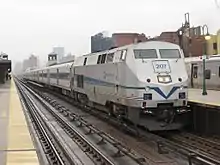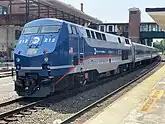GE Genesis
General Electric Genesis (officially trademarked GENESIS[5]) is a series of passenger diesel locomotives produced by GE Transportation, then a subsidiary of General Electric. Between 1992 and 2001, a total of 321 units were built for Amtrak, Metro-North, and Via Rail.
| GE Genesis | |||||||||||||||||||||||||||||||||||||||||||||||||||||||||||||||||||||
|---|---|---|---|---|---|---|---|---|---|---|---|---|---|---|---|---|---|---|---|---|---|---|---|---|---|---|---|---|---|---|---|---|---|---|---|---|---|---|---|---|---|---|---|---|---|---|---|---|---|---|---|---|---|---|---|---|---|---|---|---|---|---|---|---|---|---|---|---|---|
 GE P42DC #150 on the Cardinal in 2006 | |||||||||||||||||||||||||||||||||||||||||||||||||||||||||||||||||||||
| |||||||||||||||||||||||||||||||||||||||||||||||||||||||||||||||||||||
| |||||||||||||||||||||||||||||||||||||||||||||||||||||||||||||||||||||
| |||||||||||||||||||||||||||||||||||||||||||||||||||||||||||||||||||||
| |||||||||||||||||||||||||||||||||||||||||||||||||||||||||||||||||||||
The Genesis series of locomotives was designed by General Electric in response to a specification published by Amtrak and ultimately selected over a competing design presented by Electro-Motive Diesel (EMD). The Genesis series are the lowest North American diesel-electric locomotives, being lower than the previous-generation F40PH by 14 inches (356 mm). This height restriction allows the locomotive to travel easily through low-profile tunnels in the Northeast Corridor.
Technical design
The GE Genesis series is unique among recently manufactured North American passenger locomotives in that it uses a single, monocoque carbody design styled by industrial designer Cesar Vergara,[6] thus making it lighter, more aerodynamic,[7] and more fuel efficient than its predecessors (F40PH, F59PH, P30CH, P32-BWH). However, this makes it more costly and time-consuming to maintain and repair. In 2004, Amtrak started installing bolt-on nose cones on its units for easy replacement in the event of a grade crossing collision with a vehicle. As an example of the improvements over the predecessor locomotives, the Genesis is 22% more fuel-efficient than the F40PH while producing 25% more power.[8] In addition, all Genesis locomotives have four-stroke engines instead of the two-stroke engines previously used in EMD counterparts.
The Genesis unit is a fully computerized locomotive which automatically controls all on-board functions, thus producing high reliability while keeping the maintenance requirements low. For example, its computers can automatically reduce the power plant's output in the event that the locomotive is overheating, or suffering from low oil pressure, low water pressure, or reduced airflow into the intakes, thus making it still operable.[8]
All Genesis engines can provide head-end power (HEP) to the train drawn from an alternator or inverter powered by the main engine at a maximum rating of 800 kilowatts (1,100 hp), making each unit capable of providing HEP for up to 16 Superliner railcars. The P40DC and P42DC power plants can supply 60-hertz head-end power either from the HEP alternator with the engine speed-locked to 900 rpm (normal mode) or from the traction alternator with the engine speed-locked to 720 rpm (standby mode). In the latter case, traction power is unavailable. The P32AC-DM powerplant does not have to be locked at a certain rpm because it utilizes an HEP inverter, which allows the prime mover to run at 1047 rpm when providing both traction power and HEP, and to idle at 620 rpm (or notch three) while still providing HEP for lighting and air-conditioning when not providing traction power.
The trucks of Genesis locomotives were made by Krupp Verkehrstechnik, which has since been absorbed by Siemens Mobility; the trucks on the newest Genesis locomotives carry the Siemens name.
Models
Three models of Genesis were built by General Electric, the P40DC, P42DC, and P32AC-DM.
P40DC

The P40DC (GENESIS Series I)[9] or Dash 8-40BP (originally known as the AMD-103 or Amtrak Monocoque Diesel - 103MPH) is the first model in the Genesis series, built in 1993.[10] The locomotive operates in a diesel-electric configuration that uses DC to power the traction motors, producing 4,000 horsepower (2,980 kW) at 1047 rpm. Power output to the traction motors is 3,550 hp (2,650 kW) when running in HEP mode (900 rpm) with a 0 kW HEP load. Traction power in HEP mode decreases to 2,525 horsepower (1,880 kW) when providing the maximum 800 kW (1,100 hp) HEP load to the train. The P40DC is geared for a maximum speed of 103 miles per hour (166 km/h). The P40DC was succeeded in 1996 by the P42DC.
A feature unique to the P40DC and P32AC-DM is a hostler stand at the rear of the locomotive providing increased visibility and reversing capabilities to the engineer while conducting reverse operations. When a unit is in operation from this stand it is limited to 10 mph (16 km/h) and a dead man's switch protects against movement without an operator being present. Another unique feature to the original P40DC were the two strobes above the cab and an emergency flasher between the strobes. When they were overhauled, those features were removed.[8]
Both the P40DC and P42DC allowed Amtrak to operate heavy long-distance trains with fewer locomotives compared to the older EMD F40PH locomotives; two P40DCs could do the same work as three F40PHs. Additional deliveries of the P42DC ended up replacing the P40DCs. Three units were wrecked (819 in the 1993 Big Bayou Canot train wreck and 807 and 829 in the 1999 Bourbonnais, Illinois, train crash) and scrapped. Eight were leased and later sold to the Connecticut DOT for Shore Line East in 2005, and four were rebuilt and sold to New Jersey Transit in 2007; NJ Transit sold their units to ConnDOT in 2015. The remaining 29 units were placed out-of-service for many years. 15 of these units have been rebuilt using 2009 ARRA stimulus funds and returned to service, now in the Phase V livery, except for 822, which is painted in Phase III Heritage livery for Amtrak's 40th Anniversary.[11] The units that were not rebuilt or sold have since been scrapped.
In January 2018, ConnDOT awarded a contract to Amtrak to overhaul their twelve P40DC locomotives at the Beech Grove Shops.[12] The first unit was completed in early 2021.[13]
Upgraded and "Stimulus" P40DCs
.jpg.webp)
By 2007, New Jersey Transit had upgraded their P40DC units with updated prime movers to match the 4,250 horsepower (3,170 kW) of the successor P42DC.[14] This was done by readjusting the position of the lay shafts within the prime mover.
Amtrak has returned 15 of their P40DC units to service as part of a project funded through the American Recovery and Reinvestment Act of 2009.[15] The first of the units were returned to service in March 2010 after being overhauled at the Beech Grove Shops. They were upgraded like NJT's units had been a few years before to have 4,250 hp (3,170 kW) and match the P42DC's maximum speed of 110 mph (177 km/h). They also received updated cab signaling systems. The upgraded locomotives still have mechanical air brakes, which makes them most suitable for trains that only require a single locomotive. This differs from the electronic air brakes on the P42DC and P32AC-DM.[16] They also feature a builder's plate indicating that they were rebuilt under the auspices of the TIGER stimulus program.
P42DC

The P42DC (GENESIS Series I)[17] is the successor model to the P40DC. It has an engine output of 4,250 horsepower (3,170 kW) at 1,047 rpm, or 3,550 horsepower (2,650 kW) when running in HEP mode (900 rpm) with a 0 kW HEP load. as with the P40DC, traction horsepower in HEP mode decreases to 2,525 horsepower (1,880 kW) when providing the full 800 kW HEP load to the train.
The P42DC has a maximum speed of 110 mph (177 km/h) compared to the 103 mph (166 km/h) maximum speed of the P40DC. Tractive effort is rated at 280.25 kN (63,000 lbf) of starting effort and 169 kN (38,000 lbf) of continuous effort at 38 mph (61 km/h) given wheel power of 3,850 horsepower (2,870 kW).[3]
P42DCs are used primarily on most of Amtrak's long-haul and higher-speed rail service outside the Northeast and lower Empire Corridors. They will be replaced on long-distance service by 125 Siemens ALC-42 Charger locomotives between 2021 and 2024, but will remain in service on shorter corridor trains.[18]
Via Rail Canada has utilized P42DC locomotives since 2001, when they replaced the LRC locomotives that year. They are currently on services with speeds up to 100 mph (161 km/h), mainly on the Quebec City-Windsor rail corridor.[19]
P32AC-DM

The P32AC-DM (GENESIS Series II, short for "Passenger, 3,200 hp (2,400 kW), Alternating Current, Dual Mode")[20] was developed for both Amtrak and Metro-North. They can operate on power generated either by the on-board diesel prime mover or power collected from a third rail electrification system at 750 volts direct current; the third-rail shoes are used on the over-running third-rail into Penn Station for Amtrak units and the under-running third-rail into Grand Central Terminal for Metro-North. The P32AC-DM is rated at 3,200 horsepower (2,390 kW), 2,900 horsepower (2,160 kW) when supplying HEP, and is geared for a maximum speed of 110 mph (177 km/h). Tractive effort is rated at 275.8 kN (62,000 lbf) of starting effort from zero to 14 mph (23 km/h) and 113.43 kN (25,500 lbf) of continuous effort at 40 mph (64 km/h) given wheel power of 2,700 horsepower (2,010 kW).[4]

The P32AC-DM is unique as it is equipped with GE's GEB15 AC (alternating current) traction motors, rather than DC (direct current) motors as used in the other subtypes.[21] It is also only one of two modern American electro-diesel locomotives with third-rail capability, along with the EMD DM30AC operated by the Long Island Rail Road. NJ Transit and Exo's Bombardier ALP-45DP electro-diesel locomotive can operate from overhead catenary electrification.
The P32AC-DM is only used on services operating north from New York City, where diesel emissions through its two fully enclosed main terminal stations are prohibited. Amtrak rosters 18 P32AC-DM locomotives and uses them for its Empire Service, Ethan Allen Express, Lake Shore Limited (New York section), Adirondack, and Maple Leaf services, all of which travel to New York Penn Station. Metro-North rosters 31 P32AC-DM locomotives on push-pull trains to Grand Central Terminal; four are owned by the Connecticut Department of Transportation.
In December 2020, the Metropolitan Transportation Authority of New York board approved a Federal Transit Administration-funded $335 million contract for 27 dual-mode locomotives, based on the Siemens Charger design. The new dual mode locomotives will replace the 27 existing P32AC-DM locomotives used on Metro-North's Hudson Line, Harlem Line, and Danbury Branch; they will use third rail electric power to enter Grand Central Terminal. The order includes additional options for up to 144 more locomotives, which includes 32 additional for use by Metro-North, 20 for the New York State Department of Transportation (for Amtrak Empire Service trains), and 20 for the Connecticut Department of Transportation.[22][23]
Original owners
| Railroad | Model | Quantity | Road numbers | Notes |
|---|---|---|---|---|
| Amtrak | P40DC | 44 | 800–843 | 15 units upgraded to P42DC specifications and remain in service; 29 units sold or scrapped. |
| P42DC | 207 | 1–207 | To be replaced by 125 new ALC-42 Siemens Charger locomotives. | |
| P32AC-DM | 18 | 700–717 | Dual mode for operation on the Empire Connection into New York Penn. | |
| Metro-North Railroad | P32AC-DM | 31 | 201–231 | Dual mode for operation into Grand Central Terminal. 228–231 owned by CTDOT |
| Via Rail | P42DC | 21 | 900–920 |
See also
References
- "王涛的Development of the Low-Emission GE-7FDL High-Power Medium-Speed Locomotive Diesel Engine - 百度文库". wenku.baidu.com.
- "Genesis Series 2 - Dual Mode Passenger Locomotive for Amtrak". August 21, 2001. Archived from the original on August 21, 2001.
- "Page 14" (PDF). Archived from the original (PDF) on October 21, 2012. Retrieved August 10, 2012.
- Page 29
- "Earlier Locomotive Models". GE Transportation. Archived from the original on September 28, 2010. Retrieved September 27, 2010.
- Gormick, Greg (November 21, 2005). "High style, high tech; Putting style back on track". Toronto Star. p. D01. ProQuest 438900729.
- US 5535680, Bieber, Allen C., "Monocoque locomotive", published 1996-07-16, assigned to General Electric Company
- Warner, David C (June 1993). "AMD103: Powering Amtrak Into the 21st Century". Passenger Train Journal. Interurban Press. 24, No. 6 (186): 23. ISSN 0160-6913.
- P40DC Builders Plate https://www.flickr.com/photos/davidfullarton/4412331923/
- "Make way for the Genesis Series". Trains. Vol. 53. August 1993.
- "On Track On Line - Stored, Sold and Leased P40s". on-track-on-line.com.
- "Notice of Contract Award" (PDF). Connecticut Department of Transportation. April 25, 2018.
- "News Photo: First CDOT P40 rebuild debuts". Trains News Wire. March 8, 2021.
- Donald Albertson (September 13, 2007). "NJT 808". rrpicturearchives.net. Archived from the original on July 16, 2011. Retrieved September 27, 2010.
- http://www.amtrak.com/pdf/ARRA/Amtrak-ARRA_Project-Summary-FY-09.pdf Amtrak ARRAProject List
- Bob Johnston (October 2010). "Beech Grove to the Rescue". Trains. Vol. 70, no. 10. pp. 48–53.
- P42 Builders Plate https://www.flickr.com/photos/76498245@N05/6871547365/in/photostream
- "Amtrak to Improve National Network with New Locomotives" (Press release). Amtrak. December 21, 2018. Archived from the original on January 26, 2021. Retrieved February 3, 2020.
- "Locomotives - P42DC | VIA Rail". corpo.viarail.ca.
- P32 Builders Plate https://www.flickr.com/photos/blazer8696/4984725506/
- Brian Solomon (2000). American Diesel Locomotives. MBI Publishing Company. p. 160. ISBN 0-7603-0666-4. Retrieved September 25, 2008.
- "Joint Metro-North and Long Island Committees Meeting". Metropolitan Transportation Authority. December 2020. pp. 128–132.
- "Metro-North set to buy dual-mode locomotives from Siemens". Trains Magazine. December 14, 2020. Archived from the original on January 31, 2021. Retrieved February 1, 2021.